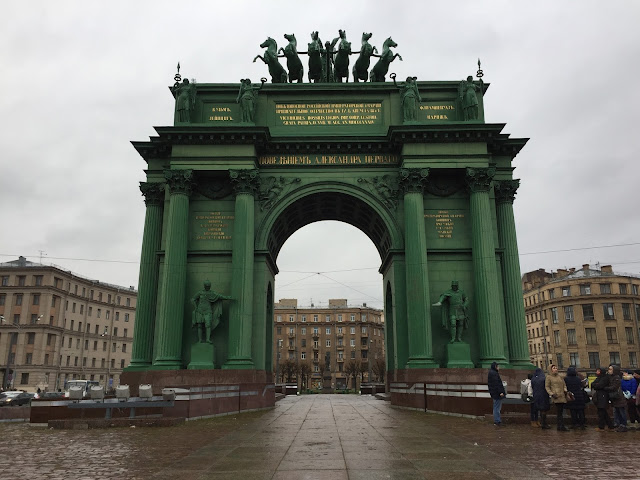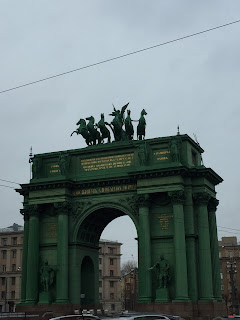160. Narva Triumphal Arch
The Narva Triumphal Arch is located in the western part of St. Petersburg, well south of the city center. The original arch (designed by Giacomo Quarenghi and intended as a temporary structure) was erected in 1814 to welcome home the Russian soldiers who were victorious over Napoleon's French invading force in the Patriotic War of 1812 (as that conflict is named in Russia). The permanent arch that stands today was designed by Vasily Stasov to Quarenghi's design and built in 1827-1834 with input from veterans of the conflict. It was heavily damaged by artillery bombardment during the Siege of Leningrad and restored in 1951.
The monument's design was inspired by the Arc de Triomphe du Carrousel in Paris (not to be confused with the more famous Arc de Triomphe de l'Étoile). The French arch is a monument to Napoleon's military victories against Austrian and Russian armies in the Austrian Empire during 1805, so it's quite amusing that a monument to his major defeat in 1812 uses a similar design.
A small museum (with just two small rooms) is located inside the arch, at the horizontal section at the top of the structure. Most of the exhibits were intended for children, and the several text panels and photographs on the walls were of little interest. I spent perhaps only 10 minutes inside.
A bronze statue of Leonid Govorov sits opposite the arch. Marshal Govorov was a Russian military leader from the 1920s-1940s, and in particular distinguished himself as a commander during the Siege of Leningrad. More impressive to me (at least from an artistic perspective) are the hammered copper statues of Russian warriors at the base of the arch (each has a twin on the other side) and the chariot, horses, and winged allegorical figures atop the monument.

The monument's design was inspired by the Arc de Triomphe du Carrousel in Paris (not to be confused with the more famous Arc de Triomphe de l'Étoile). The French arch is a monument to Napoleon's military victories against Austrian and Russian armies in the Austrian Empire during 1805, so it's quite amusing that a monument to his major defeat in 1812 uses a similar design.
A small museum (with just two small rooms) is located inside the arch, at the horizontal section at the top of the structure. Most of the exhibits were intended for children, and the several text panels and photographs on the walls were of little interest. I spent perhaps only 10 minutes inside.
A bronze statue of Leonid Govorov sits opposite the arch. Marshal Govorov was a Russian military leader from the 1920s-1940s, and in particular distinguished himself as a commander during the Siege of Leningrad. More impressive to me (at least from an artistic perspective) are the hammered copper statues of Russian warriors at the base of the arch (each has a twin on the other side) and the chariot, horses, and winged allegorical figures atop the monument.

























Comments
Post a Comment